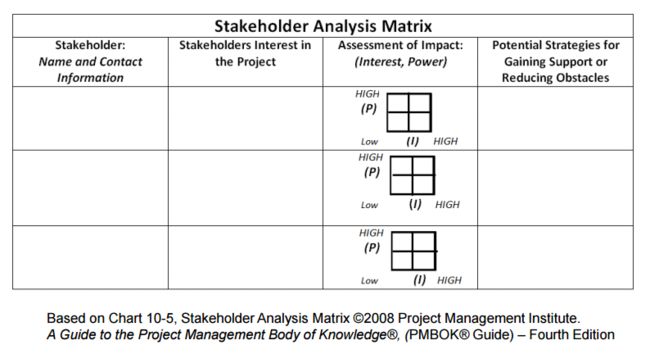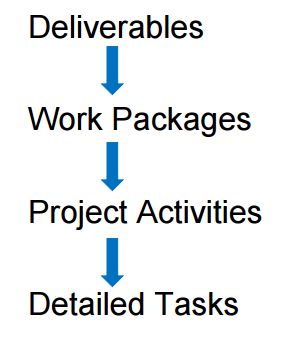该课程为coursera上的MOOC课程。
点此进入课程主页
课程目标
- Learn about the role of high performance teams and leadership in project management
- Learn about the tools and techniques for developing and strengthening high performance teams and team members
Learn about the stages in project cycle - Apply best practices to develop competencies and skills in planning and controlling projects to ensure successful outcomes
- Learn how to monitor project activities and assess progress
- Learn to communicate proficiently to report project status and performance to stakeholders and contribute to organizational knowledge base
关于该课程的学习笔记会在这里不断更新,既是对自己的督促,也希望能将自己的心得分享出来,大家一起讨论。
不足之处,欢迎各位指证。
Week 1 Foundational Project Management Elements
1.1 What is a Project?
这里提出了三个需要厘清的概念:
- What is a project?
- What is a Project Manager?
- What is Project Managemet?
A project
- has a definable goal
- has interrelated and depend tasks
- is finite in duration
- provides a unique product, service or information
- operates under scope, quality, cost and time constrains
Project: A temporary endeavor undertaken to create a unique product, service, or result.
Projects and Ongoing Work
项目管理是有开始、有结束、有明确目标的事情。
日常工作流程只是简单的按照一定的程序重复进行。
Constrains: S, Q, C, T Targets
Scope: 是指这个项目有多大
Quality: 是指对这个项目的质量要求
Cost: 是指完成这个项目需要多少花费
Time: 是指完成这个需要多少时间
当我们开始一个新项目时,首先从图中的一点开始进行规划。
You can't change one constraint without adjusting another one.
当项目进行过程中,发现需要对其范围进行扩展时,也需要对其它的三项目标进行调整。
也有教材将 Risk和 Resources加入进来,风险和资源其实是时间和成本的子集。
小结
本节课主要讲了什么是项目,其中重点为项目的约束条件(constrains),应重点理解范围、质量、成本、时间四者之间的关系。
1.2 Scope
Three Elements of Scope
- Product Scope
- All the things that will be created or delivered
- Project Scope
- All the work that will be done during the project
- Total Scope
- All the things and all the work
项目范围的不仅仅只是项目所涉目标产品、服务或结果的范围,还包括在项目进行过程中需要去做的所有工作。
The Project Manager
- Technical Skills
- 项目经理不需要精通所有的知识,但需要具备与项目相关的所有基础知识。如此才能与团队成员顺畅沟通。
- Project Management Process Skills
- 对于该项目的理解,了解从项目开始到结束每个过程的状态及成员对该项目的想法。
- Leadership Skills
- 项目经理需要与整个团队一起推进项目的运行,期间需要接触各类人,这就需要项目经理拥有良好的领导力。这是项目成功的重要因素。
The Various Roles of the PM
- Task & Human
- 项目经理需要处理项目任务,需要与团队合作
- Integrator vs. Technical Expert
- 项目经理不需要成为每个领域的专家,但是必须确保团队成员人尽其能,把正确的人放在正确的位置上要求了解每个团队成员的专长、特点。
- 整合各领域专家一起来推进项目的进展。
- Big Picture & Detail
- 项目经理既要有大局观,又要关注每一处细节。始终思考所有细节如何整合在一起构成完成的项目。
- 合理地将项目层层分解每一项小任务并制定计划。对于每一项小任务都优化至可以找到合适的人去完成。
- Politics
- 项目经理需要与各个部门的人打交道。
- Projects vs. Functions
- 团队成员可能各自有自己的日常工作,项目经理需要将团队任务整合进日常工作中。
Project Manager: The person assigned by the performing organization to achieve the project objectives.
Project Management
- Planning
- Scheduling
- Managing
- Coordinating
- Leading
- Communicating
- Controlling
Project Management: The application of knowledge, skills, tools, and techniques to project activities to meet project requirements. Project Management is accomplished through the use of processes such as: initiating, planning, executing, controlling and closing.
项目管理需要综合运用知识、技巧、工具以及技术以达到项目要求。
Process Groups
- Initiate
- 清晰地定义项目并启动项目
- Plan
- 统筹规划我们要如何完成目标
- Execute
- 拥有目标、制定计划后,就需要执行
- Monitor and Control
- 当我们推进项目的过程中,我们要监控当前的进展状态,并控制进度。我们要确保所有的进展都没有偏离目标,确保花费没有超出预算,确保各任务都能按时完成。
- Close
- 项目完成后,结束项目。
在这5项流程之中还有很多需要考虑的内容,除此以外,项目管理人员还需要了解10个领域的知识。
Knowledge Areas
- Project Integration Management
- Project Scope Management
- Project Time Management
- Project Cost Management
- Project Quality Management
- Project Human Resource Management
- Project Communications Management
- Project Risk Management
- Project Procurement Management
- Project Stakeholder Management
项目管理人员应针对这10个领域审视自己,对欠缺的部分进行补足。
小结
该节内容主要讲了项目范围的三要素,要全面考量项目产品的范围以及推进项目过程中所要进行的工作。项目的进展流程主要分为5个部分,项目管理人员则要掌握10个方面的知识。这10个方面的知识为进行项目管理提供了较好的基础,自己平时应该主动学习对自己来说薄弱的部分。
1.3 Initiating
项目启动处理所有与开始项目有关的内容,其中有两个关键的要素:
- Stakeholder(干系人)
- 所有与项目有关的个人和团体,其利益可能受项目实施或项目的完成正面或负面影响的个人和团体。干系人也有可能会影响项目及其结果。
- Customer (客户)
- 干系人的一种
- 是干系人的特殊子集
- 客户是项目成果的真正接收方
- Project Charter (项目章程)
- 起草一项章程,只需要确定两件事
- 项目名称:说明公司已经决定并正式批准进行该项目
- 项目经理的姓名:说明此人是项目负责人并有权利使用公司资源
- 不涉及项目细节,细节列在项目计划里
- 是所有参与方之间的协议,项目经理、赞助商、客户、执行团队以及主要干系人达成一致
- One location for all overview information
- Definition of the project
- Guide for the project activities
- 随时参考项目章程,检查是否在正轨上
- 起草一项章程,只需要确定两件事
Elements of the Charter and Scope Statements
| Charter | Scope Statement |
|---|---|
| Project purpose or justification | Product scope description (progressively elaborated) |
| Measureable project objectives and related success criteria | Project deliverables |
| High-level requirements | Product user acceptance critera |
| High-level project description, product characteristics | Project exclusions |
| Summary milestone schedule | Project constraints |
| High level risks | Project assumptions |
| Summary budget | |
| Project approval requirements (what constitutes success, who decides it, who signs off) | |
| Assigned project manager, responsibility and authority level | |
| Name and responsibility of the person(s) authorizing project charter | |
| Stakeholder list |
Scope Statement: The description of the project scope, major deliverables, assumptions, and constraints.
小结
本节应重点掌握项目章程,这是项目启动的关键要素。另外在项目启动时还要列明干系人。
1.4 Stakeholder Analysis
Stakeholder Analysis: A technique of systematically gathering and analyzing quantitative and qualitative information to determine whose interests should be taken into account throughout the project.
Stakeholder Analysis Matrix
小结
对于干系人的分析应做在项目开始之前,列出与该项目利益相关的个人或团体,分析他们受项目的影响情况,并提出要想获得他们的支持需要采取什么策略。项目章程和项目范围可以随着项目的进行不断地补充扩展,对于干系人的分析则应在项目开始前就考虑充分,否则有可能会对项目的进行造成干扰。
Week2 The WBS
2.1 Planning
Risks to a Project
- All projects have risks
- It is always best to know upfront
- There are numerous risk anylysis tools and methods. Use at least one.
所有项目都存在风险,提前想好可能存在的风险,才能未雨绸缪,有备无患。
Risk: An uncertain event or condition that, if it occurs, has a positive or negative effect on project's objectives.
分析风险需要四步:
- Find the risks
- Analyze the risks
- Develop a risk plan
- Mitigate the risks as they arise
通过与团队成员讨论,或者参考类似项目找到其中的风险,并把它们列出来。为其中需要当心的高风险制定某种风险计划,以便不利情况出现时,有备无患,防止措手不及。减少风险可以通过合约将风险转移,也可以对项目进行创新,规避风险。
分析风险主要针对两在要素:影响和概率。
Impact
- How bad will it be if it happens?
- How much will it affect the project?
分析风险对项目造成的可能影响及程度。
Probability
- What are the chances it will occur during the project?
- What is the likelihood that something will fail?
确定风险的影响,还应考虑风险发生的概率,对两者综合考虑来寻找应对方案。
Triggers
- Can I see it coming before it hits the project?
- Will I know when the risk has hit the project and is affecting it?
了解风险发生的标志或风险来临的信号,有助于控制风险。举例来说,新药研发项目中应综合考虑产品的风险,其中的毒性、代谢性质、活性等等数据都可以作为了解项目失败风险的指标,及时中止,避免更大的损失。
Make decisions and Take Actions Based on Risk Priorities
- Determine which risks will affect your project the most
- Decide which risks are the ones to plan countermeasures for and which to mitigate
- Plan your actions
风险有积极的风险和消极的风险,这里重点关注消极的风险。积极的风险可以通过采用措施消除或降低。将风险造成的影响以及发生的概率从1-5进行分级,并写出采用应对方案后的影响及概率评级,当风险达到企业可接受的范围时,项目就可以继续向前。
Project Tasks
- It all comes down to individual project tasks
- The project plan is the lay-out of these tasks with times and resources assigned
小结
本部分主要讲项目中所涉的风险,对于风险应该在项目开始时就将所有可能出现的风险列出来,并对其中的影响和概率进行分析,提出应对预案,将风险造成的影响降到最低。
1.2 Planning: WBS
Work Breakdown Structure (WBS)
- A way to plan the tasks
- A way to display the tasks
- A way to communicate the project complexity
工作分解结构,计划项目任务、展示任务、沟通项目复杂性。WBS指针对可交付成果对项目要素的分组,每下降一层,代表对项目工作做更详细的定义。其中关键应该在于至上而下,由大化小,层层分解。
WBS: A deliverable-oriented grouping of project elements that organizes and defines the total scope of the project. Each descending level represents an increasingly detailed definition of the project work. Work not in the WBS is outside the scope of the project.
Why a WBS?
WBS是开展项目必须要做的工作,它具有如下的作用:
- Foundation for planning the project
- Project planning is based on the tasks displayed on the WBS
- Provides a detailed illustration of the project
- Defines human resource cost estimates
- Provides clear assignments to project members
Deliverables and Tasks
工作分解结构中将阐述可交付成果和任务。如下图,最高层是可交付成果,向下是工作包,工作包分解为若干个项目活动,项目活动再分解为细分任务。当我们转向做日程安排时,细分任务将放入项目日程中。
其中关键在于,将所有信息放入工作结构分解。
Identify the Tasks
- First define the deliverables
- Then identify the tasks that will create or provide those deliverables
这里讲如何确定任务,方法很简单,先确定可交付成果,再去确认完成这些成果需要完成哪些任务。其中的关键在于,要把项目的可交付成果想清楚。
Deliverable: Any unique and verifiable product, result, or capability to perform a service that must be produced to complete the process, phase, or project. Often used more narrowly in reference to an external deliverable, which is a deliverable that is subject to approval by the project sponsor or customer.
Project Activity: A component of work performed during the course of a project.
工作分解结构包含项目围的三方面:
- Product Scope: The Things
- Project Scope: The Work
- Scope: The Things and The Work
工作分解结构的发展初期看起来如图所示,图中最高层级叫做大型项目,它是由互相联系的项目集合而成,不能进行单独管理。相关项目的组合叫做大型项目。大型项目经理要管理一系列相关的项目和项目经理。而我们大多数时候则是从项目这个层级开展。
小结
该部分讲述了WBS的作用,制定WBS对于项目的进行至关重要,其中关键在于自上而下,层层分解。
2.3 Planning and the WBS, Part 2
该部分主要是举例说明WBS各种形式,一个项目可以按可交付成果、项目活动、项目阶段等做分解。新药研发项目可能适合按照项目阶段进行分解。
对于分解后的具体工作,耗时最好是在4-40个小时之间,不宜太长也不宜太短,但具体还是要依公司而定。此时,也可以审视项目人力资源和相关成本,做项目预算。
Week3
3.1 Planning: Scheduling
The Project Schedule
- Shows the relationship of the project activities and tasks
- Shows the dependencies (which tasks follow other tasks in a logical sequence)
进度表展示项目任务和活动之间的关系,告诉我们哪些任务导致其他任务的产生,某些任务之前要完成什么。如果我们看到一项任务及其后续任务,这是从属任务。前置活动是指这项任务和在它之前要完成的任务。
可以由此看出任务是按次序进行还是可以同时进行。
Critical Path: Generally, but not always, the sequence of schedule activities that determines the duration of the project. It is the longest path through the project.
Float Time
Total Float Time (Slack Time): The total amount of time a schedule activity may be delayed from its early start date without delaying the project finish date or violating a schedule constraint.
Free Float: The total amount of time a schedule activity can be delayed without delaying the early start of any immediately following schedule activities.
Project Diagrams
- Ganntt Chart
- Network Diagram
- AOA (Activity On Arrow)
- AON (Activity On Node)
- PERT Chart (an early AON Diagram)
- CPM (Critical Path Method)
The Project Schedule
- Tasks across a timeline
- Road map
- Project
- Project Manager
- Customers and stakeholders
- Communication tool
- Tracking tool
利用项目进度表可以确定进度和项目。
3.2 Constructing a Schedule
How Do We Construct a Schedule?
- Move the detailed tasks to the schedule
- Add the task durations
- Arrange the tasks into the sequential or simultaneous relationships
- Add the initial start or finish of the overall project
- Add the early and late start and finish times
- Add whatever other information you might want, such as team members' names to tasks and costs
将工作分解结构中的任务转移至进度表,确定任务所需时间,调整任务的次序或同步任务。从项目启动或者倒推,然后添加整个项目的开始以及结束时间,然后添加每个任务的最早/最晚开始以及结束时间。最后还可以把任何需要的信息放进去。
Milestones
Milestones are zero duration tasks that designate significant events in the project
Baseline
The original approved plan (for a project, a work package, or an activity), plus or minus approved scope changes. Usually used with a modifier (e.g., cost baseline, schedule baseline, performance measurement baseline).
有时完成项目所需时间要长于项目完成要求时间,这时需要Crashing the Project及Fast Tracking the Project.
Crashing the Project
A specific type project schedule compression technique. Typical approaches to decrease the total project schedule duration include reducing schedule activity durations and increasing assignment of resources. Crashing often increases project costs.
减少进度活动时长,增加资源调用。
Fast Tracking the Project
A specific type of project schedule compression technique that changes network logic to overlap phases that would normally be done in sequence or to perform schedule activities in parallel. Fast tracking often increases risks.
Two Last Resorts
- Reduce the Scope: simply take some deliverables out of the project
- Reduce the Quality: Provide something even if it is not what was originally specified
这两种方式也许不是理想方式,但有时可能是必要的。
小结
这两次课程主要讲了进度表的作用、进度表的制订、进度表的表现形式,最后又介绍了当进度时间达不到要求时可以采取的策略。其中重点在于进度表的制订,在制订进度表的时候有赖于工作分解结构,要对任务顺序进行合理安排。
(To be continued)









